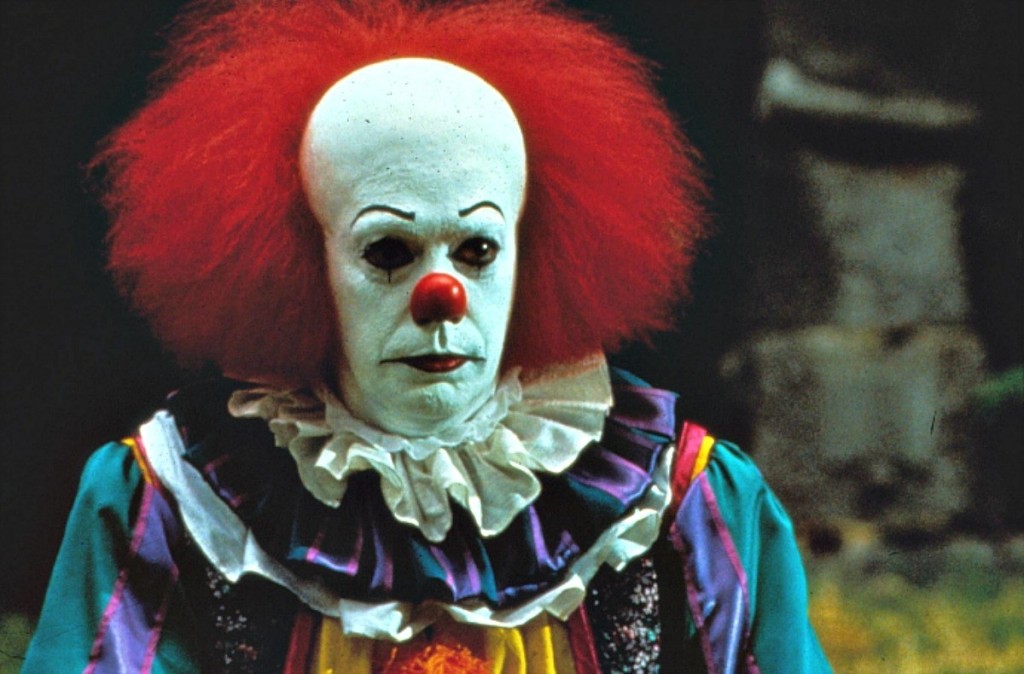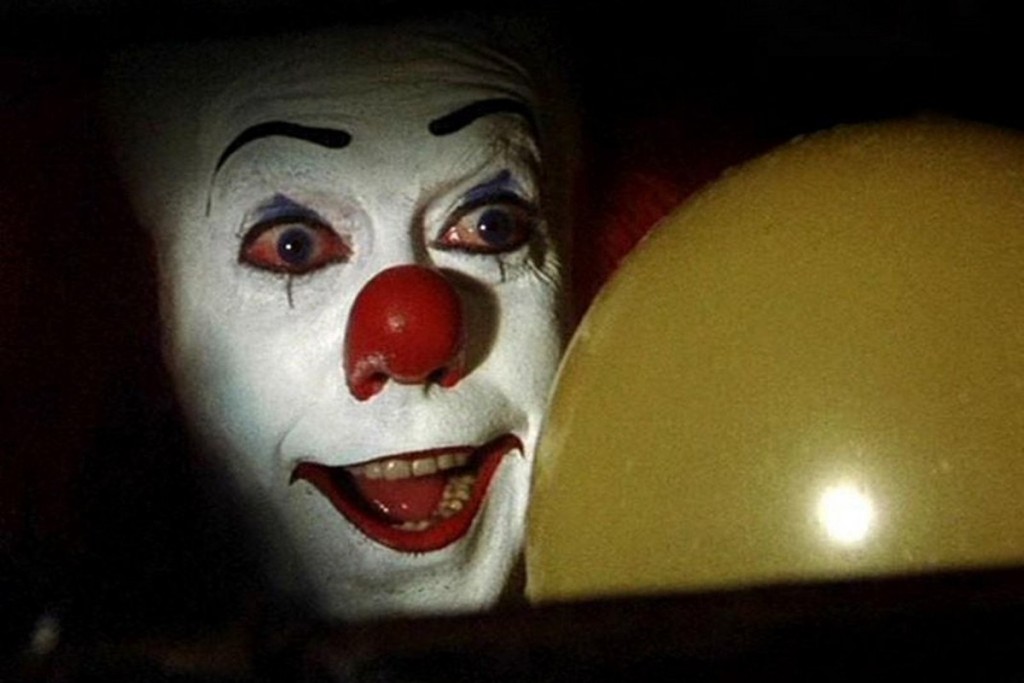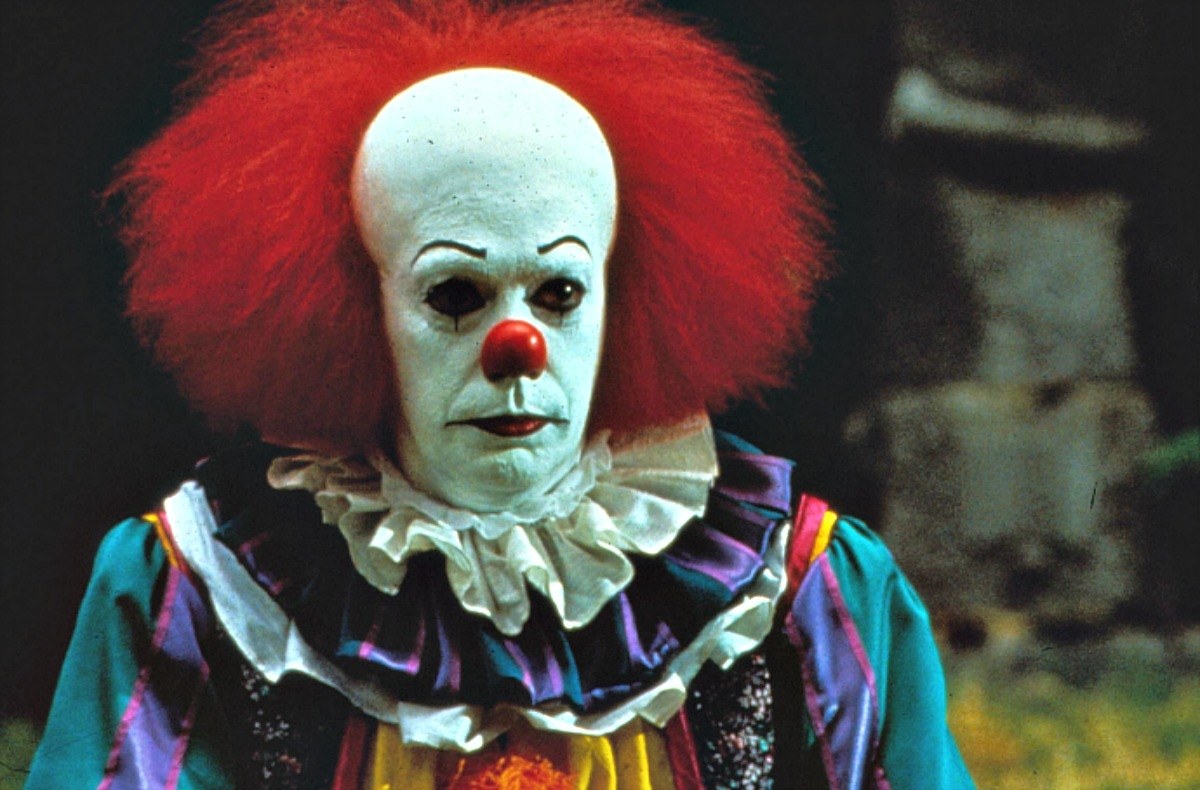
In the bifurcated narrative of Stephen King’s 1986 novel It, adapted by Lawrence D. Cohen and Tommy Lee Miller into a two-part TV movie in 1990 and back in cinemas this week with Bill Skarsgård under the Pennywise powder, childhood trauma folds into adulthood fragility.
In the second part of the original movie, generally acknowledged to be the weaker of the two, the grown-up Losers Club of Derry, Maine return to their hometown to face Tim Curry’s murderous Dancing Clown, back at it 27 years later. The young friends’ encounters with Pennywise and his shape-shifting forms are vividly dramatised in Part 1, but as adults the group struggle to recall exact details. What they know for sure is the fear–the kind of absolute terror that drives one of their crew, the sceptical Stan, to immediately slit his wrists in the bathtub–and a compulsion to return, but otherwise their heads are fuzzy, and they have to pool information to remember properly.
For some, it all floods back in the phone conversation with Mike (Tim Reid), who stayed behind in Derry as a kind of sentry, activating the Bat signal now that Pennywise is snatching up kids again. Stuttering Bill (Richard Thomas), the group’s de facto leader, had even forgotten about his young brother Georgie, lured into a storm drain in the film’s opener. The adults, called back to the town, remember bits and pieces, but are surprised by the difficulty of narrowing down memories. Pennywise is a horror that lurks in their head, a feeling or set of images — fuzzy buttons, balloons— rather than a accurate, recallable event. For film fans my age, the experience of the TV movie is much the same.
The prospect of returning to It two decades later triggered a morbid trepidation not dissimilar to the feelings of the grown-up Losers. Memories of watching the two-parter, some few years after initial broadcast, are cloudy. I was probably in my grandparents’ house. They lived next door and let my brother and I stay up, trawling the forbidden haul of random late-night programming. It was in their armchair, set close enough to the TV set to hug it, that I inhaled the horror cinema imagery that has stuck through the years, like the eyedrops scene in Fritz Kiersch’s Children of the Corn (another King story) or the part in 1998’s seaborne shlocker Deep Rising when a tentacle mouth vomits up a half-digested cruise passenger, images that played on barely-understood fears about vulnerability and bodily breaches.
The question of what scares us as kids, and what carries into adulthood, is arbitrary and uncertain; a right time, right place sort of thing. Images survive, distorting and transforming over time. I was convinced that Pennywise’s terrorizing of Eddie in the school showers featured the circus fiend squeezing out of the shower taps, but I was conflating two separate images: the shower pipes leering and crowding poor Eddie like hostile antenna, and the clown slurping out of the drain in the centre of the floor like its made of putty.
I remember, clearest of all, the feelings surrounding the film — confusion, unease, a guiltiness about watching something profane.
Above all, kids want to feel safe. It attacked this desire for security with its environment of total hostility. Stories about childhood often employ a last-summer nostalgia for a sense of lost innocence, laments about the compromises and rationality forced by growing up. And there’s something in It about that. Adults can’t see the monster because they’ve grown up, because they don’t believe, in it or in much of anything. Out in the woods, building a dam and riding bikes, the kids seem to exist in a golden world. But being young and having belief doesn’t shield them. It turns them into targets.

The monster in It is a disturbing slippery kind of threat, one that resists categories and form. There is a feeling of unreality. Bodies bend and tuck and fit into impossible spaces; an old photograph comes to life.
The fluidity is chronological too. It establishes a distinction between childhood and adulthood but dramatises how they feed into eachother, how trauma and fears fester, replicate and recur. Bev replaces her abusive father with an abusive boyfriend. Ritchie drowns out the persistent fear with the dim of showbiz chatter. Eddie’s still a virgin. As a kid, I assumed that growing up was a process of radical transformation. Adults knew what to do. They weren’t afraid of silly things. Their feet stood firm.
The realisation that we can grow up and still be fundamentally unsafe was a disorientating one. The middle-aged Losers Club have had full lives in the interim, with careers and marriages, but when they get the phone call they’re back home and it’s like no time has elapsed, a circle that’s finally returned to its point of origin. A child-killer with razor teeth is scary, sure; but the idea that there are things you can’t ever recover from, that’s really terrifying.
In King’s novel, the monster takes generic forms, appearing as screen icons like Dracula or Frankenstein etc, a firmer emphasis on the kids’ individualised nightmares. In the movie he’s a werewolf for Ritchie, as per the matinee the Losers attended , but mostly builds its horror on images of perverse normality. Balloons filled with blood; a gurgling sink coated in the stuff; a circus act with a pitbull’s face. And of course, most of all, Tim Curry’s frumpy, ordinary, lame clown, his menace pivoting on a devastating shift of tone, like an uncle at a barbecue who grabs your arm a little too tight. The more the film leans into canonical scares, like the fortune cookies that pop with roving eyeballs or pincher claws, the sillier and less effective it is.
Giving exact form to terror can diminish it. As a three-hour adult viewing experience, much of It is corny and dated. And the ending — in which the adults triumph by kicking a giant spider to death like a inter-species punishment beating — is a dopey letdown of the highest order. But this mattered less to coming of age audiences, drawn to clear imagery and an insidious undermining of assumptions about the dangers of the world, and the adults that were supposed to protect you from them.
At its strongest, It‘s terror was a subterranean, ‘down there’ force, the kind that sloshes around in our secret pipes and drains, the dark plumbing that runs underneath and in between all the ordinary things. Conor Smyth
It (1990) is available on DVD and Blu-ray. It (2017) is on wide release from Friday 8th September. Read our review.




